| Polly Gould Penguin Pool |
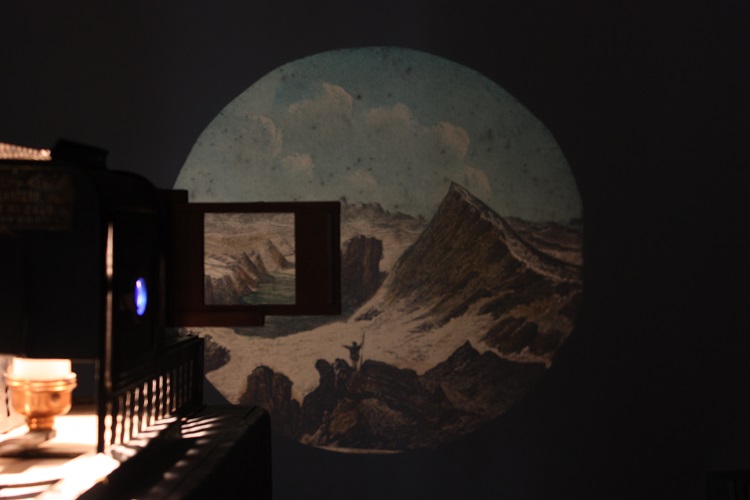 |
|
Penguin Pool 2015 performative lecture |
|
Thursday 19 March 2015 |
|
Performance's documentation on vimeo Preamble to Penguin Pool by Polly Gould: I start with a preamble to Penguin Pool by giving a bit of context. The two key references that got me started on this line of thought have been the following: a lecture titled ‘Some Remarks on Penguins’ by the explorer Edward Wilson which he gave in 1902 while on expedition to Antarctica, and a glass lantern slide that I bought on e-bay of the 1934 Lubetkin design for the penguin pool at London Zoo. Edward Wilson (1872-1912) Antarctic explorer of the heroic age, the expedition doctor, naturalist, and watercolour artist, worked in the medium of watercolour to make landscape paintings. Wilson was also an ornithologist keen to explore theories on evolution that he expected analysis of the Emperor penguin eggs would prove. Edward Wilson wrote ‘Some Remarks on Penguins’ as an article that he provided, and a lecture that he gave for the education of the small audience of the expedition while passing the time at the Antarctic base at Cape Evans. The South Polar Times was a hand drawn and typed periodical produced by the explorers for their own edification and amusement, in the cramped housing of the hut. In this magazine Wilson was frequently caricatured as a penguin. In 1911, during the Terra Nova expedition led by Scott, Wilson Bowers and Cherry-Garrard made a journey in the mid-winter to Cape Crozier to collect the Emperor penguin eggs. Wilson hoped to collect evidence for a theory popular at the time - put forward by Ernst Haeckel amongst others - that the history of a creature’s evolution could be seen recapitulated in its embryonic development. With great effort and near tragedy, these three penguin eggs were collected, and the explorers returned to the hut. Bowers and Wilson later died on the subsequent south polar journey, but Cherry-Garrard returned to civilization to offer these three eggs to the curator of the Natural History Museum. Cherry-Garrard recounts in The Worst Journey in the World a comedic coda in which he finds himself insisting that the museum curator, who displayed acute disinterest, should issue a receipt for the eggs the collection of which had cost Cherry-Garrard and his companions such trouble. The museum curators were not inclined to take the eggs seriously – they had arrived a little too late, the First World war intervened, the researcher died, and they were put aside until the 1930s, by which time the recapitulation theory had become defunct, and the interest in penguins as ancient birds had also been discredited. Years later in early 21st century, the eggs are readable in ways were not intended on their collection. DNA material is collected for comparison. The chemical content of the shells is analysed to give indications of climate change. The question of shelter, habitation; survival (or not) in the face of an extreme climate can be considered through the Wilson archive. The Edward Wilson archives are amongst those that hold the memory of the heroic dead, the memorialization of a particular kind of masculinity, of imperial exploration, of ethnographic judgments, of colonial exploitation. Antarctica figures as the unbuilt environment outside of human history in stark contrast to the built environment of human work; it is all that is natural rather than artificial, born rather than made. The empty continent is the only territory on Earth devoid of indigenous human population, and is, consequently, entirely available to fantasies of self-invention, colonial or otherwise. Nineteenth century advances in ideas had opened time past backwards into astonishing extensions of prehistory. With the publication of Charles Lyell, Principles of Geology, Being an Attempt to Explain the Former Changes of the Earth's Surface, by Reference to Causes Now in Operation first published in three volumes in 1830-1833 geology became a hot topic. The striations of geological rock in one location, the global distribution of similar types across the lithosphere, told a story of the planet’s history that was one of change and process over millions of years that testified against the intelligent design of God’s own creation. Paul J. Crutzen's recent coining of the term 'anthropocene' to describe the new geological age in which human behaviour changes the planet’s atmosphere has become a new hot topic. The anthropocene potentially names the change from the Holocene (the last 10-12,000 years), which describes the period of the colonization of the planet by humans, and relative climate stability. As it is strata that defines epoch, Crutzen dates three stages of the anthropocene from the industrial development of the 1790s steam engine, readable in a layer of carbon laid down in measurable strata in the ice cores. The British Stratographic Commission will make a decision in 2016 as to whether they accept this new nomenclature as a formal geological term. One of my glass magic lantern slides depicts an unknown Edwardian geologist in a quarry circa 1900 pointing to something in the rock face – what is he trying to indicate with his walking stick stretched out towards some strata above his head? Might he be telling us of our future legibility in the geological record, -“You will have been here.” A nineteenth century definition of transparency dated as 1874, ‘A photograph or picture on glass or other transparent substance intended to be seen by transmitted light’, puts it right at the start of the historical period of Edward Wilson’s life. It reminds me of the function of the lantern slide show as the medium and motor for the telling of art history, as is the historian’s text, the lantern slide show as a vehicle for disseminating the geographical explorer’s tales. Stocking, the historian of anthropology, describes the sociocultural evolutionism of that period as the product of the ‘attempts to understand the cultural experience symbolised by the Crystal Palace.’ Stocking writes that the system of ethnological collecting that demonstrates evolutionary principles based upon classification by form, ‘bears an obvious resemblance to that employed in judging at the Exhibition.’ And I suppose it also resembles the approach of the architectural historian to writing architectural history as an evolution of forms. The narrative of evolution behind Wilson’s collection of penguin eggs, and architectural formal modernism come together in another lantern slide in the sequence: the Lubetkin Penguin Pool at London Zoo, 1933-1934. The development of the new material possibilities of reinforced concrete allowed for the application of design innovation for displaying the animals. The Lubetkin design is structured with a pair of interlacing ramps - formally similar to the pattern of a genetic chiasm found in sexual reproduction, in which a pair of chromosomes cross-over to exchange data - these platforms lead nowhere but display the animals to great effect. In recent decades the zoo has gone from a site for the display of animals, to become a place for the conservation of the gene pool of endangered species. The archive and the gene pool are both collections of information. In Rules for the Human Zoo: a response to The Letter on Humanism Peter Sloterdijk’s 1999 reply to the letter Heidegger wrote in 1946 regarding the place of Humanism in current civic society, Sloterdijk discusses how humanism had been founded on the reading of the great writings to keep tame the bestial inclinations of man. Sloterdijk argues it is no longer the humanist who has this concern or care, but the archivist who has taken over the responsibility for returning to the old texts. The narrative for Penguin Pool is provided by a series of citations, including some from the Sloterdijk’s Rules for the Human Zoo. The other citations in order of appearance include; Victorian collector and anthropologist, Augustus Lane-Fox Pitt-Rivers The Evolution of Culture and Other Essays, 1906, and his progeny grandson George Lane-Fox Weeds in the Garden of Marriage 1931, a nasty little eugenicist manifesto. Elizabeth Grosz Histories of a Feminist Future 2000; Edward Burnett Tylor Primitive Culture, 1913; The Anthropocene Working Group, 2015; Henry R. Knipe From Nebula to Man 1905, the story of geology in rhyming couplets; Living Animals of the World 1905, illustrated natural history book and compendium of killing and collecting; Edward Wilson Some Remarks on Penguins, South Polar Times, 1902; George Seaver’s biographies, Edward Wilson of the Antarctic: Naturalist and Friend, 1933 and Edward Wilson Nature Lover, 1937; an article by Iain Sample in the Guardian on birdsong and speech; film titles from the film New Architecture of London Zoo, 1936, by Maholy-Nagy featuring the Lubetkin penguin pond; David Barnes on Climate Change in Antarctica in The Naked Scientists interview 2010; George Clark Simpson’s climate change science fiction in The South Polar Times, 1911; D’Arcy Wentworth Thompson, On Growth and Form 1913-1941, and his contribution to The Antarctic Manual for the use of the Expedition of 1901; Susan Stewart, On Longing: Narratives of the Miniature, the gigantic, the Souvenir, the Collection, 1993; Marie-Eve Morin, The Coming-to-the-World of the Human Animal in Sloterdijk Now, 2012; Leonard Huxley, Scott’s Last Expedition, 1913; Claude Levi-Strauss, Triste-Tropiques, 1961; Claire Colebrook, Death of the Posthuman: Essays on Extinction, Vol. 1, 2014; The British Antarctic Survey, 2015 on The Antarctic Treaty 1959; and The Antarctic Manual for the use of the Expedition of 1901. For a species to survive its numbers must not go below an optimum number of individuals. I have a collection here of forty-six slides - the same as the number of chromosomes in the human genome. On your arrival you were asked to select a lantern slide card from the display in the entrance hall. Each of you has unwittingly become responsible for the quote on your card. We number less than the complete set by about six to ten people. Unselected cards mean unspoken citations in the performance. We are not numerous enough to perform the full text. I have assembled these slides from my efforts as an e-bay buyer. They were chosen to fit my current narrative inclination and set of themes, but the lantern images are uprooted from their initial narrative context. Sometimes what is depicted has been forgotten, or become unrecognisable. It will now entail a group effort to perform the narrative contained in the lantern-slide sequence. I have assembled the sequence for the lantern slide show – this is set – what is not set is the citations that will be spoken. Your prompt is your chosen lantern-slide appearing on the wall. Please indicate that you have the quotation card and you will be passed the torch to read the text. You can read out the quote, you can choose to stay silent, you can choose to add some comment of your own. The lantern-slide of the Lubetkin penguin pool at London Zoo marks the half-way point of the sequence. I am the lantern-slide operator – you are the tableau vivant and available pool of narrative data. Now, if you are all ready, let’s begin - Penguin Pool. |
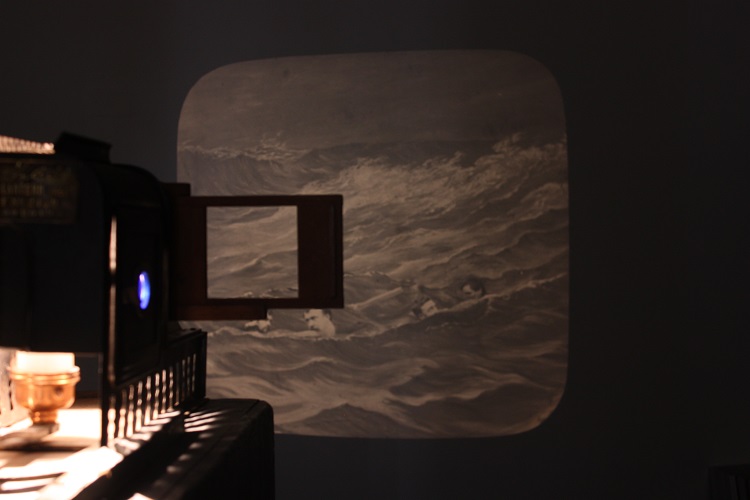 |
|
Penguin Pool performative lecture 2015 |
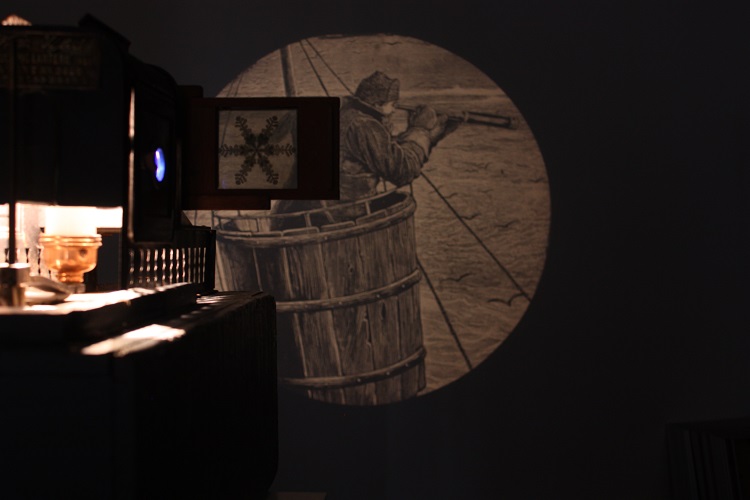 |
|
Penguin Pool performative lecture 2015 |
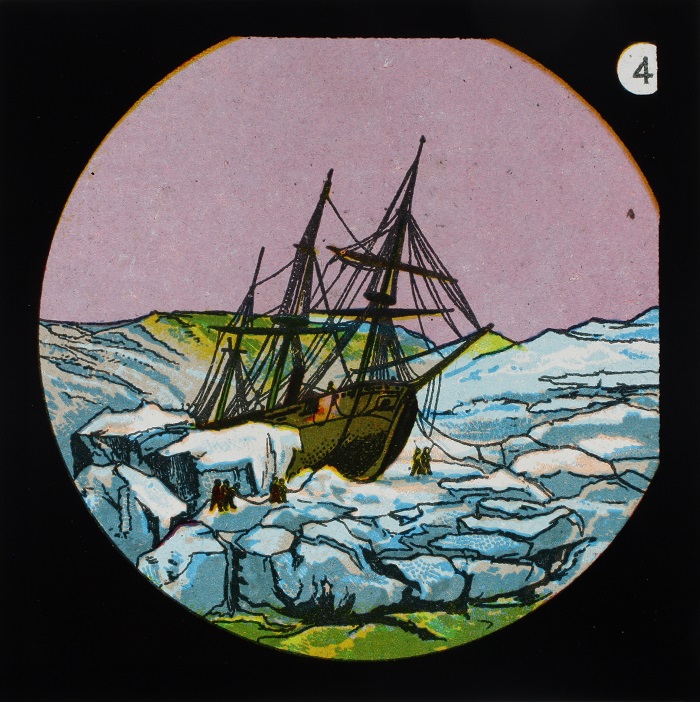 |
|
Penguin Pool performative lecture 2015 |
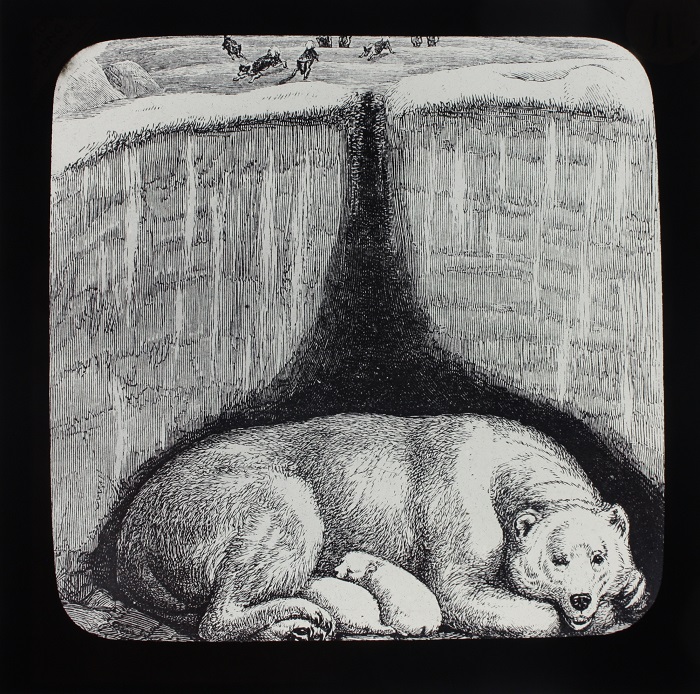 |
|
Penguin Pool performative lecture 2015 |
| >home |